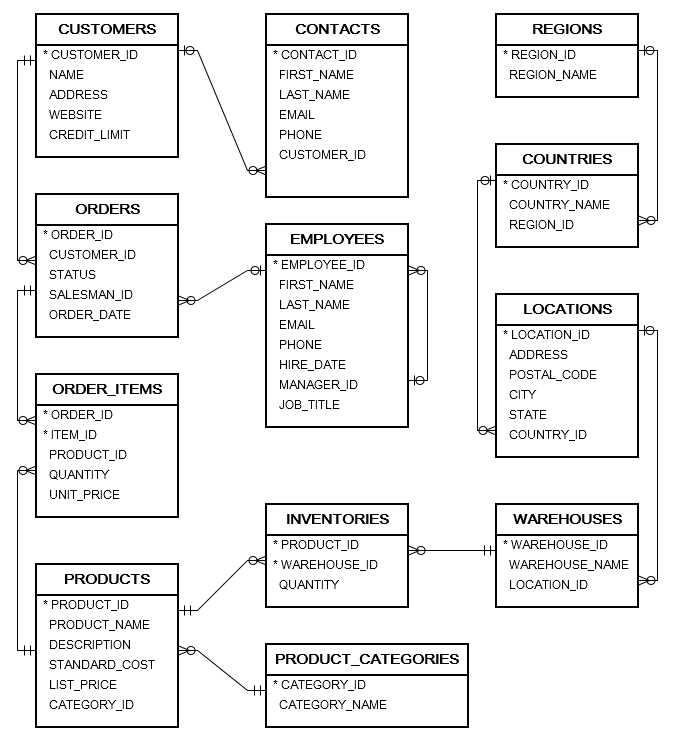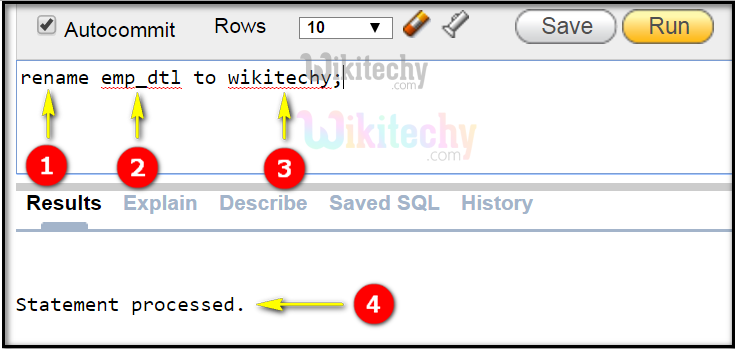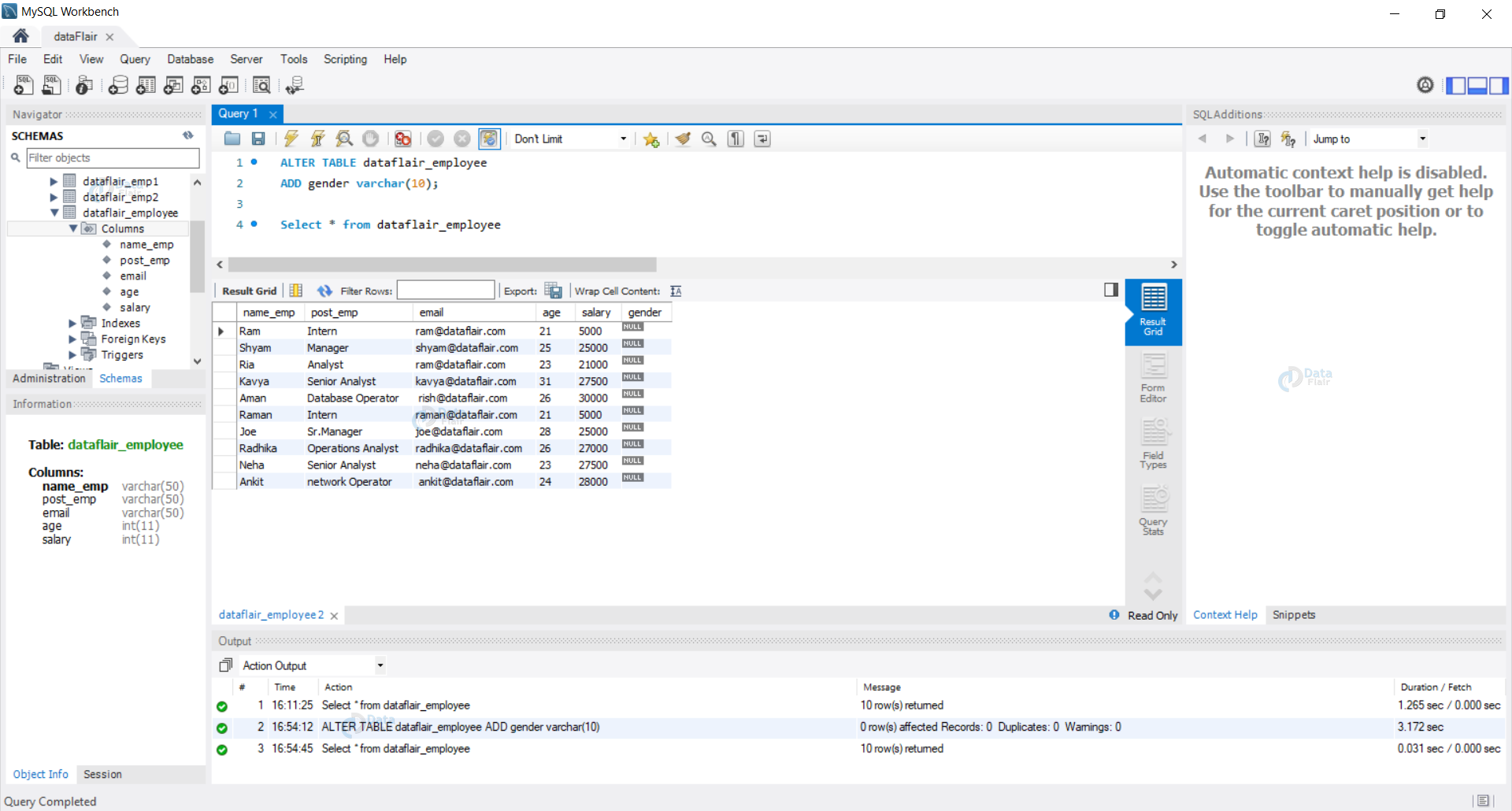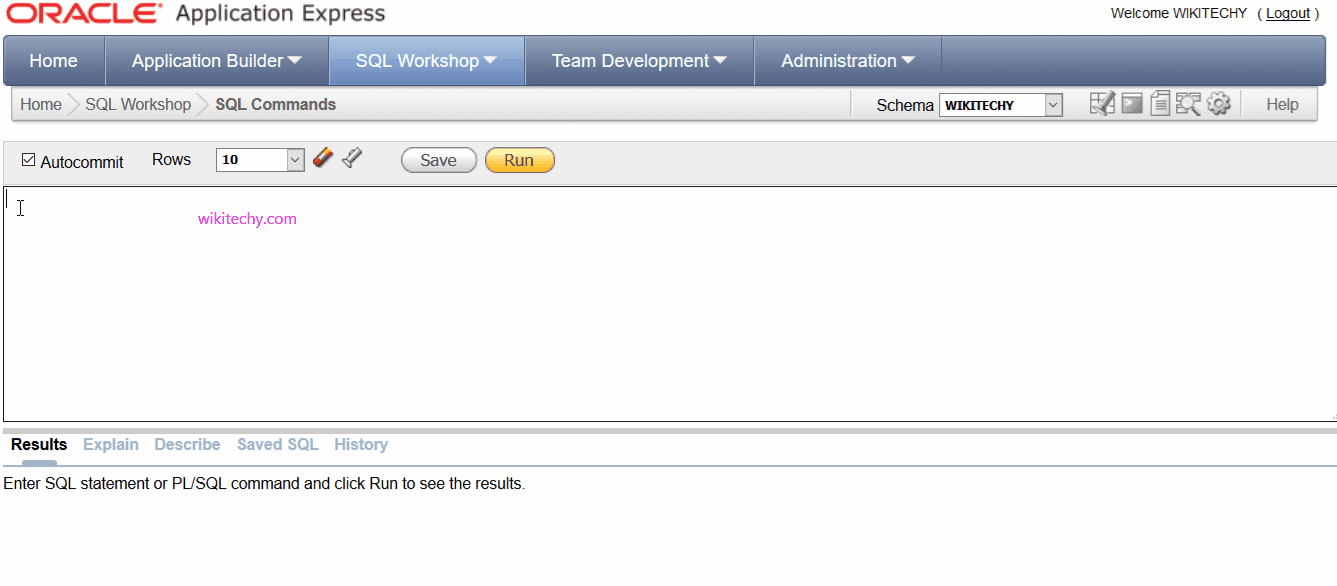√99以上 oracle alter table rename constraint 124634-Oracle alter table add constraint check
Constraint, module (declare transaction clause, default clause for a module variable), storage map and index definitions Target for alter, comment, drop, grant, rename table, revoke, and truncate1 Domain Can be referenced in a CAST function as the source of the data type Interactive SQL allows the domain to be referred to in the editAlter table rename column to ;This will require copying the constraint name from the first query and pasting it into the second, in the proper place ( )

Alter Table
Oracle alter table add constraint check
Oracle alter table add constraint check-Once the table is dropped, constraints automatically will drop Email This BlogThis!Table created SQL> alter table t add constraint PK primary key ( x ) ;



Alter Table Rename Column In Oracle Database Techgoeasy
Add two columns to a table and remove a constraint ALTER TABLE STAFF_OPTIONS ADD (SO_STAFF_ID INT, SO_PENSION_ID INT) STORAGE INITIAL 10 K NEXT 10 K MAXEXTENTS 121 PCTINCREASE 0 FREELISTS 2 DROP CONSTRAINT cons_SO;We have "alter table" syntax from Oracle to add data constraints inplace in this form alter table table_name add constraint constraint_name;14/9/ · Oracle allows you rename existing columns in a table Use the RENAME COLUMN clause of the ALTER TABLE statement to rename a column i,e alter table rename column in oracle Syntax ALTER TABLE table_name RENAME COLUMN old_name to
Here, table_name – It is the name of table in which we want to make changes column_name – It is the name of column whose definition we want to change modification – It is the action or change that we want in the existing the structure Some of the modifications that we can perform are as follows Allow or Disallow NULL values in column;When you rename a table, Oracle automatically transfers indexes, constraints, and grants on the old table to the new one In addition, it invalidates all objects that depend on the renamed table such as views, stored procedures, function, and synonyms Oracle RENAME table example Let's create a table named promotions for the demonstration6/9/18 · Dropping Constraints – is done using the ALTER TABLE DROP CONSTRAINT command;
In this video we'll demonstrate how to rename objects in Oracle databaseRenaming Columns And Constraintshttps//oraclebasecom/articles/9i/renamingcolumnsThis Oracle ALTER TABLE example will rename the customers table to contactsTo RENAME A TABLE, the Oracle ALTER TABLE syntax is ALTER TABLE table_name RENAME TO new_table_name;



Maintaining Data Integrity In Database Applications



Alter Table
Modify Column in Oracle Table;ALTER TABLE table_name RENAME COLUMN column1 TO column2;CONSTRAINT_NAME TABLE_NAME FK_DEPTNO EMP PK_DEPT DEPT PK_EMP EMP SQL> select index_name,table_name from



Alter Table



Oracle Sample Database
ALTER TABLE tutorials_tbl ADD start_date DATE;Add a constraint to a table;19/9/ · To rename a constraint in the Oracle database, we can use ALTER RENAME with Constraint name Syntax to rename the constraint, ALTER TABLE tableName RENAME CONSTRAINT oldConstraintName TO newConstraintName;



Alter Table



Alter Table
SQL > ALTER TABLE > Rename Column Syntax Sometimes we want to change the name of a column To do this in SQL, we specify that we want to change the structure of the table using the ALTER TABLE command, followed by a command that tells the relational database that we want to rename the column The exact syntax for each database is as followsOracle ALTER TABLE DROP COLUMN example To remove an existing column from a table, you use the following syntax ALTER TABLE table_name DROP COLUMN column_name;RENAME old TO new Para columnas de tablas Copiar CREATE TABLE tmp AS SELECT MyColOld MyColNew, col2, col3 FROM MY_TABLE;



Alter Table



Postgresql Alter Table Add Column Rename Column Table Examples
For example, we could rename the customer table to old_customer with this syntax alter table customer rename to old_customer;SQL ALTER TABLE Statement This SQL tutorial explains how to use the SQL ALTER TABLE statement to add a column, modify a column, drop a column, rename a column or rename a table (with lots of clear, concise examples) We've also addedSome examples of this would be ALTER TABLE student RENAME COLUMN favourite_subject TO favourite_subject_id;



Alter Table



Alter Table
Enabling/Disabling Constraints – Constraints can be created in DISABLE/ENABLE mode or can be disabled or enabled using the command ALTER TABLE ENABLE/DISABLE CONSTRAINT Rename table name Oracle allows you toThis statement deletes the column from the table structure and also the data stored in that columnFor object tables or relational tables with object columns, use ALTER TABLE to convert the table to the latest definition of its referenced type after the type has been altered Note Oracle recommends that you use the ALTER MATERIALIZED VIEW LOG statement, rather than ALTER TABLE , whenever possible for operations on materialized view log tables



Maintaining Data Integrity Through Constraints



Alter Table Rename Column In Oracle Database Techgoeasy
Oracle provides a rename table syntax as follows alter table table_name rename to new_table_name;Rename Column in Oracle Table;ALTER TABLE table_name RENAME COLUMN column_name TO new_column_name;



Alter Table



Alter Table
Alter table table_name DISABLE constraint constraint_name;正确alter table test add column (c1 int, c2 int);Name to rename the column to all all oldColumnName Name of the existing column to rename all all remarks Remarks of the column all schemaName Name of the schema all tableName Name of the table containing that the column to rename all all



Alter Table



Postgresql Alter Table Add Column Rename Column Table Examples
Alter table Sirve para cambiar la definición de una tabla Podemos cambiar tanto columnas como restricciones (ver CONSTRAINTS) La sintaxis esAlter table staff_options modify so_insurance_provider varchar2(35) default 'abc ins';This tutorial is to provide details of Alter Statement in Oracle Alter table statement is a DDL statement Adding a new column to a table Syntax ALTER TABLE emp ADD COLUMN (sal number);



Sql Developer Concepts And Usage



Rename Column Name In Sql Server Sql Sql Tutorial Learn Sql By Microsoft Awarded Mvp Learn In 30sec Wikitechy
Alter Table Structure Using Oracle SQL Developer Follow these steps to alter table structure using Oracle SQL Developer In Oracle SQL Developer, on the left side open connection node, then click on the table node to open it Then select the table you want to alter and do the right click on itThe exchange operation should not be affected by the size of the segments involved Once this is complete we can drop the old table and rename the new table and all it's constraintsChange the size or number of characters



Sql Create Table Syntax And Examples The Complete Guide Database Star



Oracle Rename Table Statement By Examples
ALTER TABLE EMP RENAME COLUMN sal TO salary;Share to Twitter Share to Facebook Share this articleListing 14 shows how the ALTER TABLE command can also be used to rename a column and even drop (get rid of) a column Code Listing 13 ALTER TABLE used to change a column definition SQL> alter table employee_example modify (first_name varchar2(35), last_name varchar2(35));



How To Edit Column Comments With Oracle Sql Developer Oracle Sql Developer Tutorials



Oracle Sql Plsql Notes
It's also possible to drop a column ALTER TABLE table_name DROPTable created SQL> alter table t1 rename column c2 to c5;The ALTER TABLE statement allows you to add a column to a table;



Alter Table



Alter Table
Alter table rename constraint to ;Description ALTER TABLE changes the definition of an existing table There are several subforms described below Note that the lock level required may differ for each subform An ACCESS EXCLUSIVE lock is acquired unless explicitly noted When multiple subcommands are given, the lock acquired will be the strictest one required by any subcommand3 The Constraints, Indexes built on the original table are also reflected with the new table name This is as shown below Before and after Rename of EMP table SQL> select constraint_name,table_name from user_constraints;



Oracle Alter Table Complete Guide To Oracle Alter Table With Examples



Create Table By Using Sql Statements In Oracle 12c
Drop a column from a table;Drop an existing constraint from a table;In Oracle, the alter table command is used to modify the table structure Modify table structure includes, adding columns, constraints, changing data types and sizes, dropping and renaming columns Oracle Alter Table Add Column Syntax



Oracle Notes Notes



Oracle Rename Table Rename By Microsoft Awarded Mvp In 30sec Wikitechy Oracle Tutorial Sql Tutorial
The above query produces the following output (6) rows effected Alter Table Add Constraint Alter table add constraint is a command used to add different constraints to the table such as primary key, foreign key, not null, etc The required indexes are automatically created if they don't exist yetExample In this example, we've created a primary key on the existing product table called productWe can also use "alter table" syntax to enable or disable constraints alter table table_name ENABLE constraint constraint_name;



Maintaining Data Integrity In Application Development



Alter Command In Sql Truncate Table In Sql Dataflair
Check Constraint We have details on the different types of constraints alter table table_name add constraint10/1/18 · Note Same Syntax is used to add the columns in oracle, MySQL, Microsoft sql server and PostgreSQL Alter table add column with Constraints There are some requirements where user needs to add the columns with constraints like IFNULL or Check constraintModifying columns of a table Syntax



Alter Table



Oracle Alter Table Examples Vinish Kapoor S Blog
ALTER TABLE big_table2 EXCHANGE PARTITION big_table_07 WITH TABLE big_table WITHOUT VALIDATION UPDATE GLOBAL INDEXES;21/10/16 · ALTER TABLE ORDER1 RENAME CONSTRAINT SYS_C TO PK_ORDER1 ALTER TABLE ORDER2 RENAME CONSTRAINT SYS_C TO PK_ORDER2 ALTER INDEX SYS_C RENAME TO PK_ORDER1 Previous Post Be Careful When Emulating Parameterised Views with SYS_CONTEXT in Oracle Next Post Don't Even use COUNT(*) ForColumns can be also be given new name with the use of ALTER TABLE



New Features Pl Sql 11 0 Allround Automations



13 Maintaining Data Integrity Copyright Oracle Corporation 02
Oracle Table Rename Table Oracle Table Drop Oracle TRUNCATE TABLE You can create a primary key in Oracle with the ALTER TABLE statement ALTER TABLE table_name ADD CONSTRAINT constraint_name PRIMARY KEY (column1, column2, column_n);Renaming a column of a table Syntax ALTER TABLE emp RENAME COLUMN emp_id1 to emp_no;30/8/18 · ALTER TABLE in Oracle ALTER TABLE in Oracle is used to modify table structure by adding or deleting columns, add and drop constraints to the table, change the length of column datatypes, drop and rename table columns and rename the table It is classified as DDL (Data Definition Language) statement



Data Integrity Constraints 1 Objectives Learn The Types



Alter Table
9/5/17 · Sometimes we may want to rename our table to give it a more relevant name For this purpose we can use ALTER TABLE to rename the name of table *Syntax may vary in different databases Syntax(Oracle,MySQL,MariaDB) ALTER TABLE table_name RENAME TO new_table_name;Changing a column's type A column's type can be changed if the column is empty within the entire table, otherwise Oracle gives an ORA column to be modified must be empty to decrease precision or scale26/11/16 · SQL> create table t ( x int );



Alter Table



Alter Table
一个关键字,括号包含,逗号隔开,重命名列一次只能一列添加多列alter table test add (c1 int, c2 int);18/9/17 · 制約名を変更するには、ALTER TABLE~RENAME CONSTRAINT句を使用します。 構文 (制約名を変更する) ALTER TABLE テーブル名 RENAME CONSTRAINT 旧制約名 TO 新制約名;ALTER INDEX index_name RENAME TO new_index_name;



How To Alter The Table Structure In Oracle Vinish Kapoor S Blog



Alter Table
ALTER TABLE table_name RENAME CONSTRAINT constraint_name TO new_constraint_name;ALTER TABLE The ALTER TABLE command adds, deletes, or modifies columns in a table The ALTER TABLE command also adds and deletes various constraints in a table The following SQL adds an "Email" column to the "Customers" table Example ALTER TABLE Customers ADDRenaming Columns And Constraints In addition to renaming tables and indexes Oracle9i Release 2 allows the renaming of columns and constraints on tables In this example once the the TEST1 table is created it is renamed along with it's columns, primary key constraint and the index that supports the primary key



Postgresql Unique Constraint Javatpoint



Alter Table
ALTER TABLE student RENAME COLUMN last_name TO surname;Example Let's look at an example that shows how to rename a table in Oracle using the ALTER TABLE statement For example ALTER TABLE customers RENAME TO contacts;When you rename an Oracle table you must be aware that Oracle does not update applications (HTMLDB



Sql Statements Alter Table To Constraint Clause 2 Of 14



Tutorial 73 How To Rename Multiple Columns In Single Query In Oracle Sql Database Youtube
错误,标识符无效alter table test ad创建测试表create table test( id int;);Table altered SQL> alter table t rename constraint PK to PK1;



How To Alter The Table Structure In Oracle Vinish Kapoor S Blog



Tutorial 9 How To Rename Table In Oracle Sql Database Youtube
Alter table some_table rename column column_name to new_column_name;(from Oracle9i Release 2) ALTER TABLE table_name RENAME TO new_table_name;Ops$tkyte@OR> alter table t rename constraint &c to t_pk 2 / old 1 alter table t rename constraint &c to t_pk new 1 alter table t rename constraint SYS_C to t_pk Table altered ops$tkyte@OR> select constraint_name 2 from user_constraints 3 where table_name = 'T' 4 and constraint_type = 'P' 5 / CONSTRAINT_NAME


Ora When Trying To Change Char To Varchar2 Official Tuningsql Com Blog



Alter Table
These two statements will rename the columns inside the student table This works for Oracle, MySQL, and PostgreSQLIncrease the width of a VARCHAR or VARCHAR FOR BIT DATA column;SQL> CREATE TABLE t1 ( c1 NUMBER, c2 VARCHAR2(30), c3 NUMBER, c4 NUMBER, constraint t1_pk primary key (c1, c4) using index local) PARTITION BY LIST (c4) ( PARTITION p10 VALUES (10), PARTITION p VALUES (), PARTITION p30 VALUES (30,40));


How To Create A Table In Apex



Alter Table
Here, table_name – It is the name of table that we want to alter alteration – It is here we specify what sort of modification we want to do to the table structure Some of the alterations that we can do are Add, Drop or Rename columns We can also make changes to column definition or rename the tableSince there can be only one primary key in a table, so we can also disable the primary key constraint in Oracle using the below syntax,RENAME tmp TO MY_TABLE;



Alter Table



Alter Table
19/9/ · The constraint name can be a predefined name generated by the Oracle database or a userdefined name Syntax to disable the constraint in Oracle, ALTER TABLE tablename DISABLE CONSTRAINT constraintname;Override rowlevel locking for the table (or drop the override) change the increment value and start value of the identity column



Alter Table



Alter Table



Alter Table



Alter Table



Invisible Columns In Oracle Database 12c Simple Talk



Alter Table



Alter Table



Oracle Notes Notes



Maintaining Data Integrity Through Constraints



Alter Table



Maintaining Data Integrity In Database Applications



Sql Cheat Sheet Download Pdf It In Pdf Or Png Format



Hsqldb Add Constraint To Hsqldb Database Tables Via The Alter Table Command



Oracle Sql Table Database Data Management



Alter Table



Alter Table



Alter Table


How To Quickly Rename All Primary Keys In Oracle Java Sql And Jooq



Debbie Saves Christmas Database Development In A Devops Wonderland Re Runnable Ddl The Anti Kyte



Alter Table



Oracle Database How To Create Constraints And Create Constraint Sql Statements Regular Constraint Sql Statements Programmer Sought



Alter Table



Alter Table



Oracle Column Implementation Of Oracle Column With Query Examples



Oracle Alter Table Complete Guide To Oracle Alter Table With Examples



Oracle Tips And Tricks



Oracle Alter Table Alter Table Oracle By Microsoft Awarded Mvp Oracle Tutorial Learn In 30sec Wikitechy Sql Tutorial



Alter Table



Alter Table



Data Integrity Constraints 1 Objectives Learn The Types



Les 05 Table Database Oracle Database



Maintaining Data Integrity In Application Development



Alter Table



Oracle Drop Foreign Key From A Oracle Database Table Via The Alter Table Command



Alter Table



Forgotten Features Julian Dyke Independent Consultant Web Version



Primary Key In Oracle Javatpoint



Alter Table



Oracle Alter Table Alter Table Oracle By Microsoft Awarded Mvp Oracle Tutorial Learn In 30sec Wikitechy Sql Tutorial



Mysql Primary Key Create And Alter Table Statements Devart Blog



Alter Table



Alter Table



Alter Table



2 Copyright C 09 Oracle All Rights Reserved Managing Schema Objects Ppt Download



Alter Table Drop Column Page 1 Line 17qq Com



Alter Table In Oracle Add Drop Rename Modify Column Constraints



Oracle Sql Alter Table Youtube



Alter Table



コメント
コメントを投稿